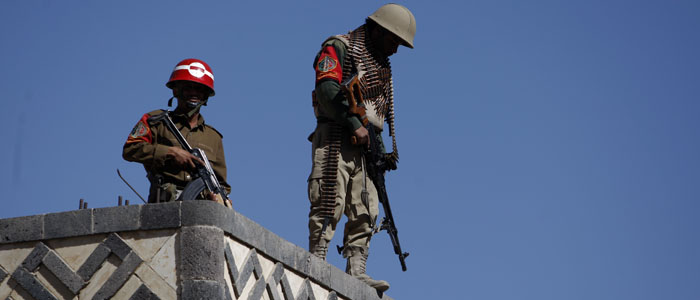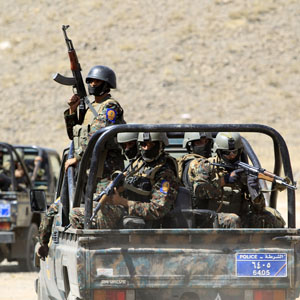
The closing of U.S. embassies throughout the Middle East due to threats from al-Qaida in the Arabian Peninsula (AQAP) indicates that however successful the U.S. drone program has been, the terrorist group continues to be a resilient, adaptable opponent. On July 16, AQAP second-in-command Said al-Shihri was killed by a suspected drone attack in Yemen, demonstrating the usefulness of unmanned aerial vehicles in degrading al-Qaida’s strength there. Yet the country’s interior safe havens allow AQAP to persist even as it endures drone strikes and government military offensives. To address this problem, a new approach is required.
Background
Last year, Yemeni military operations were largely successful in pushing AQAP out of the southern areas it had overrun in 2011. Since retreating to its traditional safe havens toward the country’s interior, however, al-Qaida has returned to its insurgent roots as its tries to reconstitute its forces.
 AQAP’s first priority is to create the operational space it needs to regrow. Toward this end, it has undertaken a concerted assassination campaign against Yemeni security, military, and intelligence officials in the provinces where it is most active, such as Abyan, Shabwa, Marib, Hadramawt, al-Jawf, and Bayda. It has also targeted Popular Committee tribal leaders who provided the government with intelligence, local guides, advisors, and clearing/holding forces during the 2012 offensive in the south. The assassination campaign has killed over ninety Yemeni officials and tribal leaders, typically through motorcycle, suicide, or improvised explosive device attacks. Such operations require knowledge of the victim’s daily routine, pre-positioning of assassination teams, and constant surveillance of the target, suggesting that AQAP has a pervasive infrastructure in Yemen – one largely undetected by intelligence personnel.Al-Qaida has also made limited incursions into several governorates – such as Bayda in April, Hadramawt in May, and Lahj in June – in order to hold key villages and demonstrate its continued capabilities. In addition, it has expanded its criminal fundraising efforts (e.g., robberies, protection rackets, blackmail, smuggling) and used various propaganda efforts to intimidate the people, dishearten the government’s local allies, and maintain its public profile (e.g., leaflets, speeches, and graffiti).Toward a ‘forward strategy’
AQAP’s first priority is to create the operational space it needs to regrow. Toward this end, it has undertaken a concerted assassination campaign against Yemeni security, military, and intelligence officials in the provinces where it is most active, such as Abyan, Shabwa, Marib, Hadramawt, al-Jawf, and Bayda. It has also targeted Popular Committee tribal leaders who provided the government with intelligence, local guides, advisors, and clearing/holding forces during the 2012 offensive in the south. The assassination campaign has killed over ninety Yemeni officials and tribal leaders, typically through motorcycle, suicide, or improvised explosive device attacks. Such operations require knowledge of the victim’s daily routine, pre-positioning of assassination teams, and constant surveillance of the target, suggesting that AQAP has a pervasive infrastructure in Yemen – one largely undetected by intelligence personnel.Al-Qaida has also made limited incursions into several governorates – such as Bayda in April, Hadramawt in May, and Lahj in June – in order to hold key villages and demonstrate its continued capabilities. In addition, it has expanded its criminal fundraising efforts (e.g., robberies, protection rackets, blackmail, smuggling) and used various propaganda efforts to intimidate the people, dishearten the government’s local allies, and maintain its public profile (e.g., leaflets, speeches, and graffiti).Toward a ‘forward strategy’
Given AQAP’s persistence in Yemen, U.S. policymakers need to rethink their strategy against the group. This means facilitating the long-term expansion of Yemeni security forces and government services to areas where al-Qaida’s influence is most developed in order to complement and eventually replace the current drone-centered strategy. In particular, Washington should help Sana’a launch a decentralized pacification campaign that mirrors AQAP’s structure and soft-power strategy while applying counterinsurgency best practices, thereby leveraging the local population against the group.
“A Yemeni citizenry protected by government security services, enlisted in its own defense, and empowered to make local political decisions would be a resilient and enduring check against the return of al-Qaida and its false promises of a better future.” – Daniel Green, The Washington Institute

Defendants linked to al-Qaida are seen at the state security court of appeals, in Sana’a April 23, 2013. (Reuters)
Although counterterrorism missions are an essential component of any strategy to defeat AQAP, they are insufficient and perhaps even counterproductive in the long term due to the risk of civilian casualties. What is needed is a low-visibility, relatively inexpensive strategy in the provinces – a realistic approach focusing on good governance, development, reconstruction, and security activities that complement the ongoing counterterrorism campaign.
Organizing for victory.A pacification program focused on extending Yemeni government sovereignty to AQAP safe havens will require dedicated effort and a blending of traditional governance, development, and security approaches. Operational design will compensate for diminished resources. Washington’s first step should be to create a separate entity at its embassy in Yemen to concentrate on developing a deeper relationship with officials and agencies responsible for service delivery to the provinces.
Focusing on the countryside. Once it has established a province-focused organization, Washington should review its current security, governance, and development programming, giving priority to regions where AQAP is strongest and to those Yemeni ministries most involved in provincial affairs. This will require reorienting some resources away from development, counterterrorism, and political reporting, and toward stabilization, pacification, and political action. For example, it is not unusual for U.S. officials to undertake development programs in relatively safer areas of Yemen because of the ease of working with local officials there. Yet many such areas have more highly developed governance structures and greater capacity than elsewhere, suggesting that some development programming can be reallocated to more unstable regions.
Enabling a “clear and hold” strategy. After forming the necessary relationships with key Yemeni military and civilian officials, U.S. pacification teams should then deploy to the countryside with Yemeni security forces and embed with provincial officials. The goal of these teams should be to advise the Yemeni military as it confronts AQAP, clears areas held by the group, and transitions to a population-protection posture. Once this step is achieved, the Yemeni military should partner with local tribes and police to bolster their strength as part of an enduring strategy to prevent al-Qaida from returning. As with the Anbar “Awakening” movement in Iraq and the Afghan Local Police program, U.S. officials should explore the possibility of helping Sana’a regularize its tribal supporters into legitimate, defensively oriented security forces.

Members of Yemen’s anti-terrorism unit are seen during training exercises near Sana’a February 20, 2012. (Reuters)
Defeating AQAP’s soft-power strategy. Once security has been established in these provinces, Washington should deploy Civil-Military Support Elements to their capitals. Partnering with local governors, these teams should focus on extending the central government’s reach, facilitating good governance, providing humanitarian aid, conducting needs assessments, and otherwise enabling U.S. civilian development programming. Embedding with select provincial governments will also help U.S. personnel mentor local leaders in a manner consistent with the central government’s goals.
Internationalizing the struggle. In carrying out this restructured strategy, Washington should partner not just with other nations interested in defeating AQAP, but also with international institutions such as the World Bank, Gulf Cooperation Council, and World Health Organization. U.S. personnel will be at greater risk once they deploy to the countryside, so sharing the risks with international institutions will enhance safety and mission success. Credibility is important as well – an expanded U.S. presence will be better received if it is undertaken with international legitimacy.
Conclusion
A Yemeni citizenry protected by government security services, enlisted in its own defense, and empowered to make local political decisions would be a resilient and enduring check against the return of al-Qaida and its false promises of a better future. Such an outcome would also make the United States safer, since AQAP will have been defeated by the very people it sought to enlist in its cause.
This post was originally published on WashingtonInstitute.org. ©2013 The Washington Institute for Near East Policy. Reprinted with permission.
The views expressed in this Insight are the author’s own and are not endorsed by Middle East Voices or Voice of America. If you’d like to share your opinion on this post, you may use our democratic commenting system below. If you are a Middle East expert or analyst associated with an established academic institution, think tank or non-governmental organization, we invite you to contribute your perspectives on events and issues about or relevant to the region. Please email us through our Contact page with a short proposal for an Insight post or send us a link to an existing post already published on your institutional blog.
